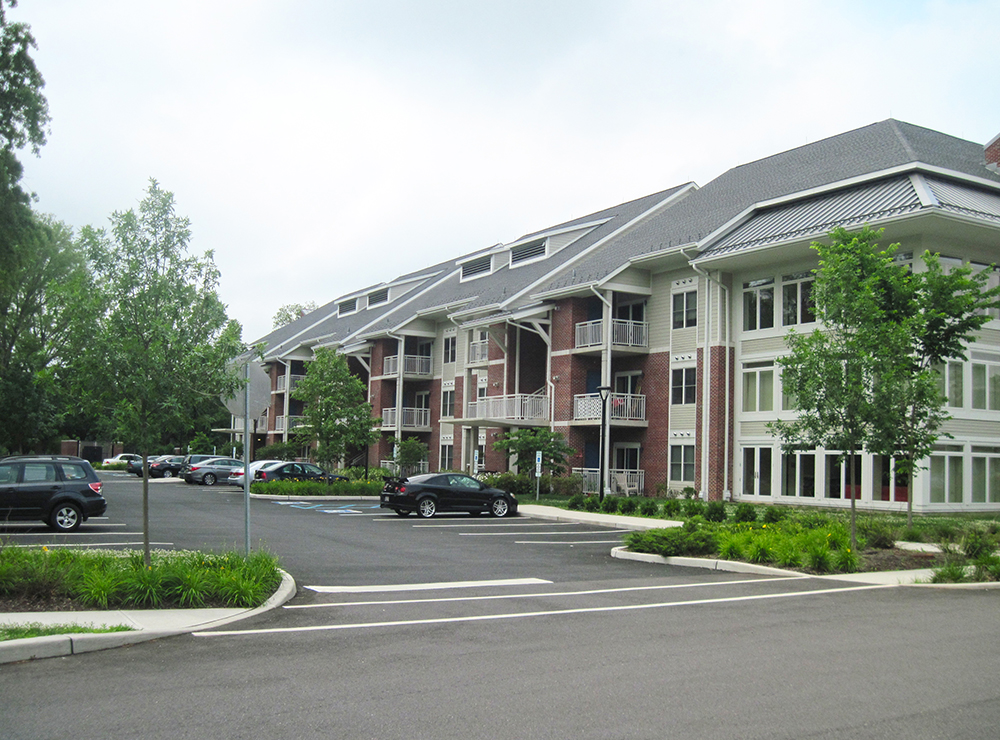
Suburban Student/Multifamily Housing: Princeton Theological Seminary, West Windsor
Suburban Student/Multifamily Housing
LOCATION:
Faber Road, West Windsor Township, NJ 08540
MUNICIPALITY/NEIGHBORHOOD:
Mixed-Use Redevelopment
DEVELOPER/DESIGN TEAM:
Princeton Theological Seminary ACT Engineers, Inc.
Dewberry
Walter Bronson, PE, LEED AP
SEWER TYPE:
The project is served by public sewers through West Windsor Township with treatment by the Stony Brook Regional Sewerage Authority.
COMPLETION DATE:
2013
Project Overview
Located in the West Windsor Campus of Princeton Theological Seminary (PTS), the 54-acre Charlotte Rachel Wilson Student Campus was originally made up of 25 buildings dating back to the 1950s. The surrounding area can be characterized as Mixed-Use, bounded by the Delaware and Raritan Canal State Park to the north, a condominium complex to the east, a shopping complex to the south, and Princeton Country Club to the west.
Since their original construction, buildings aged poorly and required extensive maintenance. Nevertheless, the complex provided needed housing that accommodated graduate students and their families. After extensive planning, PTS chose to redevelop a 23-acre portion of the complex as a LEED-accredited campus, with three garden-style apartment buildings containing 204 units and green infrastructure to manage stormwater. The aesthetically pleasing new units have upgraded the school’s housing stock and enhanced the living environment for prospective students.
The project’s proximity to the Delaware and Raritan Canal, as well as freshwater wetlands and flood plains associated with nearby Stony Brook, meant that special attention to stormwater management and water quality was needed. The development also had to be sensitive to aesthetic and historical concerns raised by the Delaware and Raritan Canal Commission (DRCC). The use of green infrastructure to manage stormwater helped to meet NJDEP, local, and regional regulatory requirements. By utilizing green infrastructure and other complimentary stormwater strategies, the designers and PTS were able to provide a conservation-minded, low-impact development that preserved the wooded character of the site.

Preserving mature trees creates a sense of permanence for the development. In addition, mature trees add property value, cool the air, reduce ground-level ozone, and absorb a large volume of water. Image Credit: Princeton Theological Seminary, 2018
Design Summary
The design team utilized green infrastructure to support a holistic vision of the development project, which sought to integrate naturalized stormwater management areas adjoining the existing wetland buffers. Natural areas dominated by hardwood trees around and within the project area were retained as much as possible.
Two infiltration basins with extended detention were installed to provide primary water quality management and stormwater detention. The basins were designed to manage stormwater in accordance with NJDEP and local requirements. The basins were carefully sited to minimize disturbance to adjacent woodlands while their naturalized landscaping visually tied them into the surroundings. The infiltration basins located at the perimeter of the site help to transition the carefully manicured landscape around the buildings to the more natural landscape beyond. The decision to send overflow from the infiltration basins to the nearby canal using existing swales rather than storm drain piping was made to reduce cost and to provide additional water quality benefits through a surface vegetated conveyance system.
Approximately 10,700 square yards of porous bituminous pavement were installed in parking lots and driveways where adequate separation to the seasonal high groundwater table could be achieved. The porous pavement served as water quality pretreatment for an underground extended detention system. An open bottom design provides some infiltration capacity.

Installation of subsurface detention cells Image Credits: ACT Engineering, Inc., 2018

Infiltration basin immediately after a storm event.Image Credits: ACT Engineering, Inc., 2018
Decision-Making
- The presence of sandy, highly permeable soils, coupled with relatively deep seasonal high groundwater levels, was one of the primary drivers for installing infiltration basins. One of the basins is an expansion and retrofit of an existing basin on site, which helped to minimize cost. The siting of the newly constructed basin repurposed an existing disturbed area to reduce the need for further encroachment into existing woodlands.
- The design utilized porous pavement at a cost of approximately $550,000 for an added level of water quality protection to satisfy the concerns of the DRCC. Porous pavement also provides the 80% Total Suspended Solids (TSS) removal required by NJDEP prior to stormwater entering the underground detention system. The design team decided to use porous pavement rather than a manufactured treatment device to achieve TSS removal out of concern for cost and/or long-term maintenance requirements.
- The contractor utilized low-ground-pressure vehicles to minimize soil compaction during construction of the infiltration basins, underground detention systems, and landscape areas.
Challenges
- Permitting for the project was complicated due to multiple agencies having jurisdiction. Clear communication of the project’s objective to minimize site disturbance was influential in obtaining approvals from different regulatory agencies.
- Construction challenges were overcome by paying careful attention to construction practices. For example, filter fabric was used to protect completed areas during infiltration basin and porous pavement installation. The fabric was carefully removed upon complete stabilization of the contributing drainage areas. Similarly, downstream discharge points were additionally reinforced to prevent erosion
Maintenance Overview
The porous pavement requires periodic vacuuming instead of sweeping and is estimated to cost approximately $3,500 per year. Salt is required for ice treatment rather than sand. The infiltration basins and subsurface-extended detention facilities require regular inspections to ensure the facilities are working properly. Repairs are made, as necessary, and typically include minor activities such as cleaning outlet control structures. There is essentially no required maintenance of the infiltration basins other than occasional cutting of vegetation on side slopes. The use of native hardy species around the infiltration basins reduces the need for pruning or regular watering.
